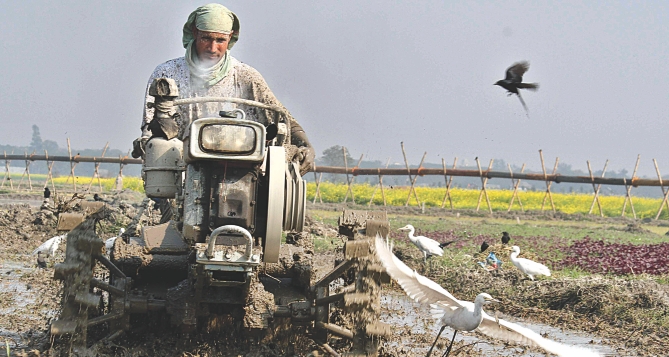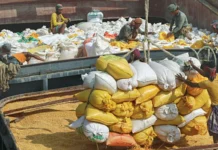Farmers bag more crops; come new jobs, go old ones

Gone are the days when farmers had to put in backbreaking labour and depend fully on animals to prepare land and thresh harvested crops.
Farmers now thresh more than 90 percent of their grain crops by machines and till nearly 90 percent of cultivable land by power tillers and tractors — a transition that took place over the last two and a half decades.
This has enabled farmers to produce more crops in a year and bag more produce with lower production cost, according to experts at agro-research institutions and Bangladesh Agricultural University (BAU).

Aware of the benefits of mechanised farming, more and more growers are now using machines for harvesting, seeding and planting.
“It has become a big boon for our farming. Using power tillers, we can prepare land quicker than we do by using animals. Machine use has reduced our time for tilling and given us scope to grow more crops,” said ASM Sisnabi Mandal, a farmer in Dinajpur district, a major crop zone in the northwest.
The 40-year-old farmer grew only two rice crops — Aman and Boro– in a year on his 10-acre farmland when he had to depend on bulls or buffaloes for land preparation. Now by using power tiller, he gets one additional crop in the same year.

“Now I grow potato or mustard after harvesting Aman rice. It is possible because less time is required for land preparation by using machines,” he said.
Sisnabi is one of the tens of thousands of farmers in the country who are reaping the advantage of using modern tools in farming.
No official estimate on agricultural mechanisation is available. But various publications and studies show that use of machines grew since the 90s.
“Mechanised farm practices expanded fast mostly for private initiatives augmented by policy support from the government,” said Monjurul Alam, professor of farm power and machinery at BAU.
Power tillers and tractors were used to prepare nearly 70 percent of land four to five years ago; their use accelerated in the last five to six years, he said.

Faced with labour scarcity and spiralling wages, farmers switched over to farm machinery, thanks to the emergence of rental services for tilling, irrigation and other farm operations.
“Farm wages rose rapidly in the past decade and a half due to a shift of labour to non-farm sectors. As a result, farmers have switched to mechanisation,” said Economist Mahabub Hossain, former director general of Bangladesh Institute of Development Studies.
Nearly 20,000 power tillers and tractors are added every year for tilling purposes, according to an International Development Enterprise estimate in 2012, commissioned by the International Maize and Wheat Improvement Centre.
Supported by the government’s scheme of subsidised sale of farm machinery in the recent years and private sector’s increased marketing and sales drive, farm machinery like power tillers, rice reapers, combined harvesters and transplanting machines are now easily available to help end the centuries-old drudgery.
“If the current trend continues, there will be a huge progress in the next five to seven years in areas lagging behind in terms of mechanisation,” said Monjurul, who conducted a study on value chain in agri-machinery in Bangladesh.

IMPACT OF MECHANISATION
Mechanisation of land preparation has contributed to timely cultivation and thus increased cropping intensity (the number of crops grown on a piece of land in a year; one crop a year means intensity 100 percent), reduced yield losses and wastage. As a result, total production of food, supported by an increased use of improved seeds, fertiliser use and commercial farming, has risen, according to analysts.
Increasing demand for agricultural machinery has also created thousands of jobs, facilitated development of the rural non-farm sector and spurred growth of farm machinery and spare parts industries.
It has also boosted establishment of workshops for repair and maintenance services in the country.
Besides being imported, threshers, maize shellers, spare parts of power tillers, diesel engines and centrifugal pumps are also made locally. The annual market for farm machinery and spare parts stands at around Tk 10,000 crore and it is growing, according to stakeholders.
Mahabub said a positive effect of mechanised farming is a reduction in the turnaround time to grow crops. “It has a positive impact on cropping intensity.”
Cropping intensity rose to 191 percent in 2012-13, up from 168 percent in 1988-89 when farm machinery imports were liberalised and the standardisation requirement was withdrawn for shortage of draught animals after the 1988 floods.
Total food grain production rose to 3.55 crore tonnes in 2013-14 fiscal year, from 1.66 crore tonnes in FY 1988-89, according to Bangladesh Bureau of Statistics.
Monjurul said mechanisation was the main factor behind increased cropping intensity in last one decade and spiral in overall food production.
The cost of production has also come down, said Mahabub.
Farmer Sisnabi said use of power tillers has reduced tilling cost of half acre to Tk 1,000 from Tk 1,400 needed for tilling by using animals.
Referring to a study, ATM Ziauddin, professor of Farm Power and Machinery at BAU, in an article said that farmers make extra gains by using power tillers for land preparation. They gain Tk 3,003 more per hectare by using power tillers instead of animals in Boro season and Tk 1,019 in Aman season.
Use of machines has also cut down the cost of threshing.
Sisnabi said it would cost him Tk 1,200 for threshing rice output of half acre of land manually. Now he can do this by spending half the amount.
“Crop wastage has also decreased in mechanised threshing. We could not collect all grains from plant through manual threshing. Now, we get almost the total,” he said.
Shoeb Hassan, chief scientific officer of farm power division of Bangladesh Agricultural Research Institute, said delayed plantation causes yield losses, but mechanised tilling has facilitated timeliness of operations.
He said more than 90 percent of grain crops are now threshed by using machines.
Traditional means of threshing causes over 10 percent loss of crops, while mechanisation has brought down threshing losses to 5 percent, he added.
“Mechanisation is the only option for timely crop production. To increase production and cropping intensity, it has become essential to mechanise certain farm operations,” according to a recent publication by Bangladesh Rice Research Institute.
However, progress in mechanised harvesting remains slow in the absence of harvesters suitable to fragmented pieces of land.
“Smaller harvesting machines are needed. Efforts should be made to see whether it is possible to introduce smaller ones,” said economist Mahabub.
Farmer Sisnabi said machines have relieved them of many hassles and tension and enabled them to do farm-related jobs timely. They now do not have to wait for labourers.
He said he is not familiar with harvesters as the technology is yet to expand in his locality. “Power tillers have become suitable for us. If harvesters are also found convenient for us and do not affect our land and environment, we will adopt that as well.”
Source: The Daily Star









